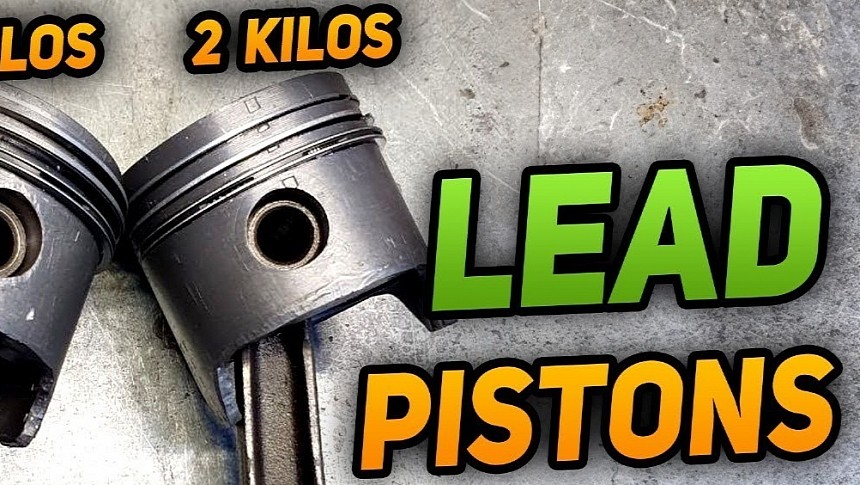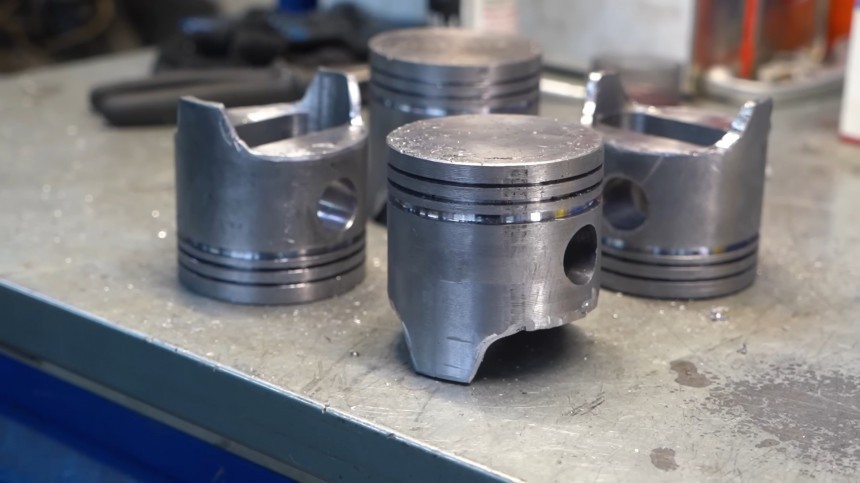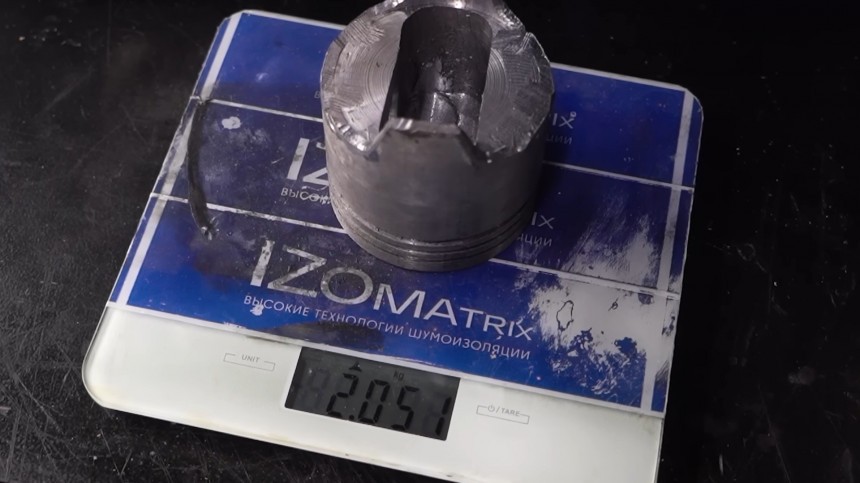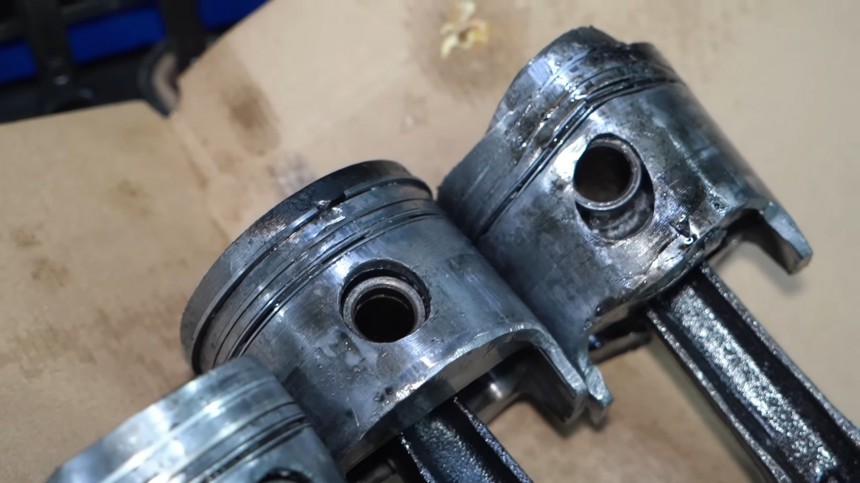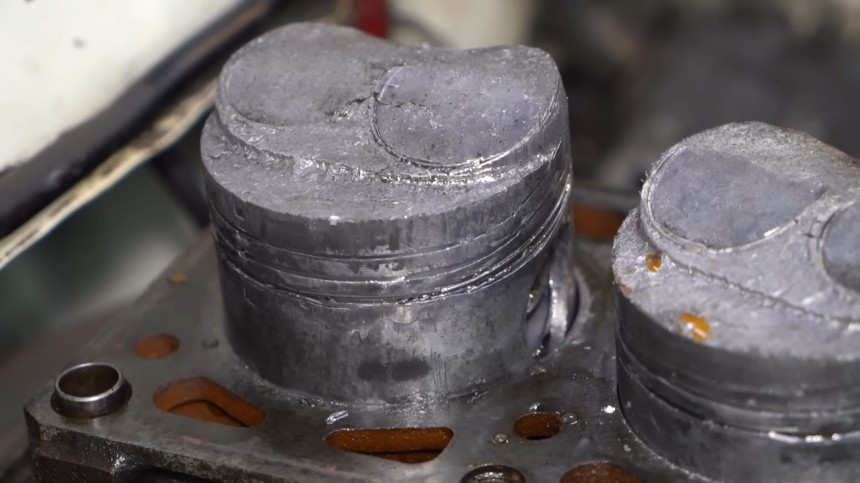Science isn’t fun if we don’t try to break or bend its limits, but sometimes this rebellion doesn’t work. For instance, we don’t make triangular wheels, perforated windshields, or lead pistons for internal combustion engines. Unless, of course, ‘we’ live in Siberia and suddenly get a wild idea. Welcome to another motoring class conducted by the Garage 54 professors from the Russian Academy of 'Physics Don’t Apply to Us.'
As any gearhead will impeccably recite, an internal combustion engine requires multiple simultaneous conditions to be met to function correctly. One of those requirements is that the pistons should have the lowest possible mass for reducing vibrations. That’s why the automotive industry relies on lightweight metals (thank you, Aluminum!) whenever possible.
Physics states that Force equals Mass times Acceleration. In a reciprocating-pistons assembly, like in any other system where motion is involved, that equation translates into Inertia. The heavier the piston and/or the higher its mass, the stronger the forces will strain the crankshaft. Think of the difference between a diesel engine and a gasoline one. Since the compression ratio is higher in the diesel, the forces exerted on the piston are proportionally larger.
The gain of this architecture is higher torque (we won’t refer to the connecting rod length here), but the downside is vibration. Well, imagine if someone were to come up with the idea of casting pistons out of lead. This dreaded metal is one dense element, at 11.34 grams per cubic centimeter; it’s also a formidable neurotoxin, so it was removed from car fuels.
And still, the boys from Garage 54 decided to give lead one more shot at automotive greatness. Since the heavy metal is also very malleable and has a relatively low melting point, it’s reasonably easy to cast into billets. However, carving pistons out of it requires quite a bit of skill and experience precisely because the metal is so soft.
The Siberian vloggers from Novosibirsk are in no shortage of either, so their lathe-cut pistons turn out (pun intended) perfectly. (Use the Russian standard of perfection, please).
Here are the cold, hard facts: the engine used in this experiment is yet another inline-four gasoline burner from a Soviet Lada. A standard piston traditionally used in this type of motor weighs 405 grams. The Garage 54-issued lead version is five times as heavy: 2,050 grams (that’s 4.5 lbs!) – that’s one helluva banger.
Let us now go back to the mathematical formula of Force. Applied to this practical (joke) experiment, it returns a crank stress value five times above the regular operating spectrum of the shaft. And the list of challenges doesn’t end there.
Due to its reduced hardness, lead will deform easily (take two identical one-foot/30-cm rods, one made of steel, the other of lead. Let’s assume they’re both a quarter-inch/6.35 mm in diameter. I promise you will be able to bend the lead one with nothing but your bare hands and minimal effort).
You can already see where this is going, right? The con rod pins will easily do the same with the lead pistons, but that’s not all there is to this mechanical failed endeavor. The ultra-heavy-pistons engine doesn’t start immediately (possibly because of lousy ignition advance). Still, it smokes pistons like jerky when it does.
That’s a very toxic literal statement – the smoke from the crankcase is thick enough to stick a knife in it, and the engine doesn’t last long before refusing to be abused any further. The wrench wizards try again and again to bring it back from the dead (lead?), only to admit defeat.
A quick compression test reveals the outcome of overstressing the engine’s internals: 1, 7.5, 2.5, and 0. The standard value should be a nudge over 9 (that’s kilograms per square centimeter, roughly 130 PSI). I’m not exactly a rocket scientist, but I’m pretty convinced that ‘zero’ has the same meaning regardless of what measurement system is used to express it.
What could be the possible cause that would lead to this anomaly? That’s exactly it – the lead in the pistons. The heavy metal quickly gave in to heat, friction, and tensile and compressive forces, and two of the pistons have effectively morphed from flat-top, low-compression into ultra-high-compression pistons withtall domes and valve reliefs.
The wrist pins on the connecting rods have simply pushed through the piston, forcing the top into a high dome that smacked the valves. The soft metal became even softer at the temperatures inside the chamber, and you can see what happened to it in the video below.
The mutilated pistons engulfed the compression rings, which scraped the lead, leaving a good tablespoon of chips on the bottom of the oil pan. Had the pistons held their own during the trial by fire, the engine would have probably disintegrated from the intense vibration. That, or the crank would have simply quit its job and broke free.
Physics states that Force equals Mass times Acceleration. In a reciprocating-pistons assembly, like in any other system where motion is involved, that equation translates into Inertia. The heavier the piston and/or the higher its mass, the stronger the forces will strain the crankshaft. Think of the difference between a diesel engine and a gasoline one. Since the compression ratio is higher in the diesel, the forces exerted on the piston are proportionally larger.
The gain of this architecture is higher torque (we won’t refer to the connecting rod length here), but the downside is vibration. Well, imagine if someone were to come up with the idea of casting pistons out of lead. This dreaded metal is one dense element, at 11.34 grams per cubic centimeter; it’s also a formidable neurotoxin, so it was removed from car fuels.
The Siberian vloggers from Novosibirsk are in no shortage of either, so their lathe-cut pistons turn out (pun intended) perfectly. (Use the Russian standard of perfection, please).
Here are the cold, hard facts: the engine used in this experiment is yet another inline-four gasoline burner from a Soviet Lada. A standard piston traditionally used in this type of motor weighs 405 grams. The Garage 54-issued lead version is five times as heavy: 2,050 grams (that’s 4.5 lbs!) – that’s one helluva banger.
Due to its reduced hardness, lead will deform easily (take two identical one-foot/30-cm rods, one made of steel, the other of lead. Let’s assume they’re both a quarter-inch/6.35 mm in diameter. I promise you will be able to bend the lead one with nothing but your bare hands and minimal effort).
You can already see where this is going, right? The con rod pins will easily do the same with the lead pistons, but that’s not all there is to this mechanical failed endeavor. The ultra-heavy-pistons engine doesn’t start immediately (possibly because of lousy ignition advance). Still, it smokes pistons like jerky when it does.
A quick compression test reveals the outcome of overstressing the engine’s internals: 1, 7.5, 2.5, and 0. The standard value should be a nudge over 9 (that’s kilograms per square centimeter, roughly 130 PSI). I’m not exactly a rocket scientist, but I’m pretty convinced that ‘zero’ has the same meaning regardless of what measurement system is used to express it.
What could be the possible cause that would lead to this anomaly? That’s exactly it – the lead in the pistons. The heavy metal quickly gave in to heat, friction, and tensile and compressive forces, and two of the pistons have effectively morphed from flat-top, low-compression into ultra-high-compression pistons withtall domes and valve reliefs.
The mutilated pistons engulfed the compression rings, which scraped the lead, leaving a good tablespoon of chips on the bottom of the oil pan. Had the pistons held their own during the trial by fire, the engine would have probably disintegrated from the intense vibration. That, or the crank would have simply quit its job and broke free.
